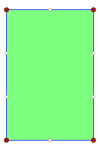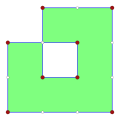Loading AI tools
Polygon with equally angled vertices From Wikipedia, the free encyclopedia
In Euclidean geometry, an equiangular polygon is a polygon whose vertex angles are equal. If the lengths of the sides are also equal (that is, if it is also equilateral) then it is a regular polygon. Isogonal polygons are equiangular polygons which alternate two edge lengths.
| Direct | Indirect | Skew |
|---|---|---|
 A rectangle, <4>, is a convex direct equiangular polygon, containing four 90° internal angles. |
 A concave indirect equiangular polygon, <6-2>, like this hexagon, counterclockwise, has five left turns and one right turn, like this tetromino. |
 A skew polygon has equal angles off a plane, like this skew octagon alternating red and blue edges on a cube. |
| Direct | Indirect | Counter-turned |
 A multi-turning equiangular polygon can be direct, like this octagon, <8/2>, has 8 90° turns, totaling 720°. |
 A concave indirect equiangular polygon, <5-2>, counterclockwise has 4 left turns and one right turn. (-1.2.4.3.2)60° |
 An indirect equiangular hexagon, <6-6>90° with 3 left turns, 3 right turns, totaling 0°. |
For clarity, a planar equiangular polygon can be called direct or indirect. A direct equiangular polygon has all angles turning in the same direction in a plane and can include multiple turns. Convex equiangular polygons are always direct. An indirect equiangular polygon can include angles turning right or left in any combination. A skew equiangular polygon may be isogonal, but can't be considered direct since it is nonplanar.
A spirolateral nθ is a special case of an equiangular polygon with a set of n integer edge lengths repeating sequence until returning to the start, with vertex internal angles θ.
An equiangular polygon can be constructed from a regular polygon or regular star polygon where edges are extended as infinite lines. Each edges can be independently moved perpendicular to the line's direction. Vertices represent the intersection point between pairs of neighboring line. Each moved line adjusts its edge-length and the lengths of its two neighboring edges.[1] If edges are reduced to zero length, the polygon becomes degenerate, or if reduced to negative lengths, this will reverse the internal and external angles.
For an even-sided direct equiangular polygon, with internal angles θ°, moving alternate edges can invert all vertices into supplementary angles, 180-θ°. Odd-sided direct equiangular polygons can only be partially inverted, leaving a mixture of supplementary angles.
Every equiangular polygon can be adjusted in proportions by this construction and still preserve equiangular status.
 This convex direct equiangular hexagon, <6>, is bounded by 6 lines with 60° angle between. Each line can be moved perpendicular to its direction. |
 This concave indirect equiangular hexagon, <6-2>, is also bounded by 6 lines with 90° angle between, each line moved independently, moving vertices as new intersections. |
For a convex equiangular p-gon, each internal angle is 180(1-2/p)°; this is the equiangular polygon theorem.
For a direct equiangular p/q star polygon, density q, each internal angle is 180(1-2q/p)°, with 1<2q<p. For w=gcd(p,q)>1, this represents a w-wound (p/w)/(q/w) star polygon, which is degenerate for the regular case.
A concave indirect equiangular (pr+pl)-gon, with pr right turn vertices and pl left turn vertices, will have internal angles of 180(1-2/|pr-pl|))°, regardless of their sequence. An indirect star equiangular (pr+pl)-gon, with pr right turn vertices and pl left turn vertices and q total turns, will have internal angles of 180(1-2q/|pr-pl|))°, regardless of their sequence. An equiangular polygon with the same number of right and left turns has zero total turns, and has no constraints on its angles.
Every direct equiangular p-gon can be given a notation <p> or <p/q>, like regular polygons {p} and regular star polygons {p/q}, containing p vertices, and stars having density q.
Convex equiangular p-gons <p> have internal angles 180(1-2/p)°, while direct star equiangular polygons, <p/q>, have internal angles 180(1-2q/p)°.
A concave indirect equiangular p-gon can be given the notation <p-2c>, with c counter-turn vertices. For example, <6-2> is a hexagon with 90° internal angles of the difference, <4>, 1 counter-turned vertex. A multiturn indirect equilateral p-gon can be given the notation <p-2c/q> with c counter turn vertices, and q total turns. An equiangular polygon <p-p> is a p-gon with undefined internal angles θ, but can be expressed explicitly as <p-p>θ.
Viviani's theorem holds for equiangular polygons:[2]
A cyclic polygon is equiangular if and only if the alternate sides are equal (that is, sides 1, 3, 5, ... are equal and sides 2, 4, ... are equal). Thus if n is odd, a cyclic polygon is equiangular if and only if it is regular.[3]
For prime p, every integer-sided equiangular p-gon is regular. Moreover, every integer-sided equiangular pk-gon has p-fold rotational symmetry.[4]
An ordered set of side lengths gives rise to an equiangular n-gon if and only if either of two equivalent conditions holds for the polynomial it equals zero at the complex value it is divisible by [5]
Direct equiangular polygons can be regular, isogonal, or lower symmetries. Examples for <p/q> are grouped into sections by p and subgrouped by density q.
Equiangular triangles must be convex and have 60° internal angles. It is an equilateral triangle and a regular triangle, <3>={3}. The only degree of freedom is edge-length.

Direct equiangular quadrilaterals have 90° internal angles. The only equiangular quadrilaterals are rectangles, <4>, and squares, {4}.
An equiangular quadrilateral with integer side lengths may be tiled by unit squares.[6]
Direct equiangular pentagons, <5> and <5/2>, have 108° and 36° internal angles respectively.
Equiangular pentagons can be regular, have bilateral symmetry, or no symmetry.

Direct equiangular hexagons, <6> and <6/2>, have 120° and 60° internal angles respectively.
An equiangular hexagon with integer side lengths may be tiled by unit equilateral triangles.[6]
Direct equiangular heptagons, <7>, <7/2>, and <7/3> have 128 4/7°, 77 1/7° and 25 5/7° internal angles respectively.
Direct equiangular octagons, <8>, <8/2> and <8/3>, have 135°, 90° and 45° internal angles respectively.
Direct equiangular enneagons, <9>, <9/2>, <9/3>, and <9/4> have 140°, 100°, 60° and 20° internal angles respectively.
Direct equiangular decagons, <10>, <10/2>, <10/3>, <10/4>, have 144°, 108°, 72° and 36° internal angles respectively.
Direct equiangular hendecagons, <11>, <11/2>, <11/3>, <11/4>, and <11/5> have 147 3/11°, 114 6/11°, 81 9/11°, 49 1/11°, and 16 4/11° internal angles respectively.
Direct equiangular dodecagons, <12>, <12/2>, <12/3>, <12/4>, and <12/5> have 150°, 120°, 90°, 60°, and 30° internal angles respectively.
Convex solutions with integer edge lengths may be tiled by pattern blocks, squares, equilateral triangles, and 30° rhombi.[6]
Direct equiangular tetradecagons, <14>, <14/2>, <14/3>, <14/4>, and <14/5>, <14/6>, have 154 2/7°, 128 4/7°, 102 6/7°, 77 1/7°, 51 3/7° and 25 5/7° internal angles respectively.
Direct equiangular pentadecagons, <15>, <15/2>, <15/3>, <15/4>, <15/5>, <15/6>, and <15/7>, have 156°, 132°, 108°, 84°, 60° and 12° internal angles respectively.
Direct equiangular hexadecagons, <16>, <16/2>, <16/3>, <16/4>, <16/5>, <16/6>, and <16/7>, have 157.5°, 135°, 112.5°, 90°, 67.5° 45° and 22.5° internal angles respectively.
Direct equiangular octadecagons, <18}, <18/2>, <18/3>, <18/4>, <18/5>, <18/6>, <18/7>, and <18/8>, have 160°, 140°, 120°, 100°, 80°, 60°, 40° and 20° internal angles respectively.
Direct equiangular icosagon, <20>, <20/3>, <20/4>, <20/5>, <20/6>, <20/7>, and <20/9>, have 162°, 126°, 108°, 90°, 72°, 54° and 18° internal angles respectively.
Seamless Wikipedia browsing. On steroids.
Every time you click a link to Wikipedia, Wiktionary or Wikiquote in your browser's search results, it will show the modern Wikiwand interface.
Wikiwand extension is a five stars, simple, with minimum permission required to keep your browsing private, safe and transparent.